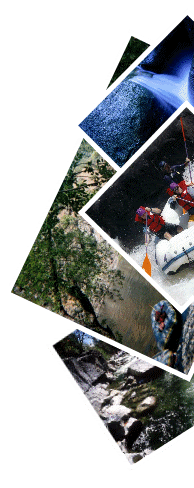From EverestNews:
We will never know the whole story of who helped David and who did not. We will never know the whole story of his summit attempt and descent where he ended up next to the previously dead climber in the rock cave on Everest. But we do know where he froze to death on Everest. Some of the media reports grow more confused, in other media stories some detail have come out. But we thought we would show you a picture of the location where David died according to some climbers statements: The Rock Cave on Everest. You will note the route to the summit is where the the rope is. You all are smart enough to figure out the rest....
EverestNews.com does not publish pictures of dead climbers, therefore the dead climber has been painted "white" in this photo. In real life the dead climber is NOT covered....
Our thoughts and Prayers go out to the family and friends of David Sharp....
Earlier Report: David Sharp from the UK has died on Everest. To the climber who has been on Everest up there, he is now in the rock cave next to the dead Indian climber. Several climbers saw David in trouble. David at some point froze to death like others before him.
This is old news for those who summited Everest the last few days. We have been waiting to report until the family was notified. We are now told the family has been notified.
Climbers saw David in various states, from standing and walking, to trying to work on his oxygen system, to at one point down on the ground.
David was clearly descending the mountain apparently from the Summit...
This article about the latest disabled climber to summit, Mark Inglis, talks about seeing him on the 15th. Numerous climbers summited on the 14th and 15th reporting him in various states. David attempted Everest by himself. He did not get himself down and therefore he died. Very Sad.
________________________________________
From MountEverest.net:
Let me tell you what it feels like on 8500 meters, deep in the Death Zone.
It depends...on 3 things:
1. The weather
2. How long you have been up there
3. And if you use (good) oxygen
If the weather is bad, you are out of oxygen (or use a bad system), and you are returning from a summit - chances are you feel like shit. Your brain is a distant blur, your legs hardly move, and you just want to sit down and sleep.
But if the weather is nice, and you have plenty of gas - it's an entirely different ball game. In good conditions, high above 8000 meters, even after a summit, you frolic in the snow, you have tea in the sun, you shoot pictures and video, you chat with fellow climbers - and maybe even call your mom.
On a mountain where all bets are off
I am not a strong climber. I seem to lack the altitude gene some of my lucky mates such as Messner and Viesturs enjoy. And I'm a woman. I have not climbed many Himalayan peaks, but I know Everest well. Ever since it first introduced itself to me, in the fateful year of 1996, Everest has been my special mountain. I returned there for 4 years, determined to show its soul to the world, through the eyes of uncensored, real adventure.
I have seen people fall horrible falls, screaming in the thin air. I have met people telling me they are ok, while they were in fact dying, without even being aware.
I have seen bad oxygen being sold to clueless climbers, and weather reports altered to fool fellow mates. I have seen false heroes hit world headlines and true heroes disappear. I have seen the cheaters, and the lies. I have listened to the Base Camp chatter, and watched the resigned look in some of my fellow climbers' eyes. For 4 years, I watched a battle between good and bad play out on a mountain where all bets are off.
The truth about us
Everest is not about the summit. Everest is just a rock. The top is the hat but the climb is the soul. A miniature of the world with no strings attached, on Everest I have seen the truth about us humans, stripped down to our barest bones.
Ever since it became known that 40 climbers stepped over a dying mate to reach the summit last week (and it's not the first time), I have seen some of my fellow climbers defending the act. Many of them, I knew, only guarding their own agendas. I watched the rest of the world become confused - is it OK to bury people alive - as long as it's on Mount Everest?
The world from a distance
Jochen Hemmleb, perhaps the foremost Everest historian today, wrote in an email today:
"For decades Everest was seen as the epitome of human challenge. In recent years, however, its role has changed. From a testing place it has been transformed into a stage on which human vanities and other habits are put on display. As Everest historian Walt Unsworth once wrote, 'Everest can bring out the best and worst in people.'"
"Mountaineering can act as an escape from society. It can also serve as means to view society from a distance. Seen in this context and keeping in mind the mountain's special role, the current events on Everest are in great part a reflection of what's going on elsewhere in society, and the questions about ethics should not be confined to Everest or climbing circles."
"The events on Everest raise some hard questions about how we, as society, regard and define success. Nowadays Everest history has come round full circle in so far as the summit seems once more to be the only goal - and few care about how it was achieved. Am I the only one who thinks that this speaks volumes, that the attitude behind this spreads beyond the climbing world to other parts of society and culture?" asks Jochen.
Choose our role models
The fact is, that the world celebrates strength unconditionally today. The next step, is to sacrifice the weak. If a climber is part of a "far less professional outfit" and "had no oxygen, and no proper gloves," he deserves to die, we decide.
The Spirit of Adventure is anything but these days. Lawsuits are filed by cheaters trying to bully their way to acceptance of false claims. Explorers with the biggest PR staff get the fame. Commerce hides bodies and damage control becomes an all important task. And it works, too.
But the question is if the problem is isolated to the community of Adventurers - or if it's a dormant cancer lying within us all. We need to talk about that, a lot, and choose our role models with better care.
This was the message Everest wanted to leave with us in 2006, ten years after Into thin air. When you check the timing between the death and miracle of David and Lincoln, it hits you that the MotherGoddess could have spoken no louder. It's not a cute message folks. It's a warning.
Tina Sjogren (born in the Czech rep) is one of the founders of ExplorersWeb. She climbed Everest in 1996 as a member of Henry Todd's outfit, and the next three years in small independent expeditions with her husband Tom (Sweden). The couple summited in 1999 after managing much of the infrastructure on Everest south side with only a team of 5 Sherpas. The expedition became famous when the couple built a wireless network high up on the mountain, and the expedition Sirdar, Babu Shirri Sherpa, camped out on the summit for 20 hours without oxygen, a dream he had long wished to try. Babu perished 2 years later in a crevasse on Everest south side camp 2. Tom and Tina later skied to both the earth's Poles (unsupported), and live in New York today.
Thanks for reading.

skip to main |
skip to sidebar




JOIN ME ON FOH BOH
If you're a part of the food or restaurant industry, or if you just love food and drink: FOH BOH is the place to be. It's the Professional Social Networking Site for anyone associated with the restaurant industry or who is a lover of food. Meet professionals in the industry. Engage. Interact. Network and Learn. Feed your Passion for Food Here. JOIN NOW.
Find more photos like this on FohBoh
Alabama
Alaska
Arizona
Arkansas
California
Colorado
Connecticut
Delaware
Florida
Georgia
Hawaii
Idaho
Illinois
Indiana
Iowa
Kansas
Kentucky
Louisiana
Maine
Maryland
Massachusetts
Michigan
Minnesota
Mississippi
Missouri
Montana
Nebraska
Nevada
New Hampshire
New Jersey
New Mexico
New York
North Carolina
North Dakota
Ohio
Oklahoma
Oregon
Pennsylvania
Rhode Island
South Carolina
South Dakota
Tennessee
Texas
Utah
Vermont
Virginia
Washington
West Virginia
Wisconsin
Wyoming
Sponsors
Pulsar Honorees
Classic MTMD
- ALASKA Day 4: In God's Country There Be Angels
- Blog Templates: I'm Going Back to Dark Dots
- Brothers Again
- Celebrating 10 Years of Rafting!
- Circles
- Formatting and Structure
- The Insignificance of Men
- Meral's Pool: What This Blog is All About
- Michelle Kwan: The True Heroine of the Olympics
- My Deliverance
- The Naming of Meltwater. Torrents. Meanderings. Delta. Part I
- Number One at Last!
- Of Fortune Cookies and Politics
- One Goal
- Os-Good, Os-Good and/or The Circle of Life
- Year of the Dog: Remembering Buffy, Mookie, and Duke
Recent Comments
Blog Archive
-
►
2009
(11)
- ► March 2009 (1)
- ► January 2009 (9)
-
►
2008
(208)
- ► December 2008 (10)
- ► November 2008 (15)
- ► October 2008 (15)
- ► September 2008 (26)
- ► August 2008 (22)
- ► April 2008 (26)
- ► March 2008 (12)
-
►
2007
(1)
- ► April 2007 (1)
-
▼
2006
(136)
- ► October 2006 (2)
-
▼
May 2006
(23)
- Wordless Wednesday
- More on David Sharp
- Death on Everest and Group Responsibility
- Dedication Friday: Touched By The Sun
- BEST PERSONAL AD EVER!
- Egg Economics
- Wordless Wednesday
- Ten Thoughts To Ponder This Week
- The Legend of Mr. Linky
- DEDICATION FRIDAY: A NEW MEME
- Missing Kona Coffee
- Bloggy Award Reviews MTMD
- Pillow Rock Meets Titanic
- Camp T-Bone
- MTMD Welcomes "Southern Expressions"
- 111 Must See Movies
- Whatever Happened to the Breakup Song?
- Cussing 101
- Dedicated To The One I Love...
- Bearly Converted
- MTMD Welcomes "Voicing My Thoughts"
- Immigration Cartoon
- Perfect Post Awards
- ► April 2006 (25)
- ► March 2006 (25)
- ► February 2006 (27)
- ► January 2006 (16)
Followers
Daily Trivia
Article of the Day
Daily content
provided by The Free Dictionary
This Day in History
Daily content
provided by The Free Dictionary
Quotation of the Day
Daily content
provided by The Free Dictionary
Translation
Road Bike Fund
About Me
- Matthew S. Urdan
- Born and raised in Detroit, I lived in Michigan the first 35 years of my life until work relocated me and I began my exile. I long for the coast of Northwest Michigan and the towns of Charlevoix, Petoskey, and Traverse City...known collectively in Detroit as "Up North" and the Murdick's Fudge and Green Rivers from my younger days.
Disclosure Policy
This blog is a personal blog written and edited by me. For questions about this blog, please contact msurdan at aol dot com.
This blog accepts forms of cash advertising, sponsorship, paid insertions or other forms of compensation.
The compensation received will never influence the content, topics or posts made in this blog. The owner of this blog is compensated to provide opinion on products, services, websites and various other topics, however those opinions are never dictated and will always be 100% my own. Even though I may receive compensation for some posts or advertisements, I always give my honest opinions, findings, beliefs, or experiences on those topics or products. The views and opinions expressed on this blog are purely my own. Any product claim, statistic, quote or other representation about a product or service should be verified with the manufacturer, provider or party in question.
This blog does not contain any content which might present a conflict of interest.
To get your own policy, go to DisclosurePolicy.org

This blog accepts forms of cash advertising, sponsorship, paid insertions or other forms of compensation.
The compensation received will never influence the content, topics or posts made in this blog. The owner of this blog is compensated to provide opinion on products, services, websites and various other topics, however those opinions are never dictated and will always be 100% my own. Even though I may receive compensation for some posts or advertisements, I always give my honest opinions, findings, beliefs, or experiences on those topics or products. The views and opinions expressed on this blog are purely my own. Any product claim, statistic, quote or other representation about a product or service should be verified with the manufacturer, provider or party in question.
This blog does not contain any content which might present a conflict of interest.
To get your own policy, go to DisclosurePolicy.org

Site Credits
©2006, 2007, 2008 Matthew S. Urdan.
All Rights Reserved.
Template by Chic & Sassy Designs inspired by a design originally created by Stephanie Davies and Matthew S. Urdan.
All content by Matthew S. Urdan except when attributed otherwise.
"Article of the Day", "This Day in History", and "Quotation of the Day" are provided by "The Free Dictionary" and are used with permission.
EntreCard
Digg This
Inside Government
Read Write React
Political Blogs with Original Thought and Analysis
From time to time I will highlight issues that are important to me in various posts on this blog. If you believe they are important also and want to take action, then this is the place to start. Type in your zip code, find your local officials, and let them know how you feel and urge them to take action. Thanks for getting involved.
|
FCDL

Meanderings

Food Industry Network
Find more photos like this on FohBoh
Matt Urdan's Posts - FohBoh
U.S. Travel
This section will be an information link resource for useful sites about and concerning travel within all fifty states. My motivation for creating this section stems completely from my experiences and lack of preparedness for travel in Alaska in winter, even though I spent many hours researching all possible contingencies. It is obviously a work in progress, so please check back often, and if you have any questions or if there is anything that I can do to help you in this regard, please don't hesitate to email me or post a comment.
Alabama
Alaska
Arizona
Arkansas
California
Colorado
Connecticut
Delaware
Florida
Georgia
Hawaii
Idaho
Illinois
Indiana
Iowa
Kansas
Kentucky
Louisiana
Maine
Maryland
Massachusetts
Michigan
Minnesota
Mississippi
Missouri
Montana
Nebraska
Nevada
New Hampshire
New Jersey
New Mexico
New York
North Carolina
North Dakota
Ohio
Oklahoma
Oregon
Pennsylvania
Rhode Island
South Carolina
South Dakota
Tennessee
Texas
Utah
Vermont
Virginia
Washington
West Virginia
Wisconsin
Wyoming











2 comments:
Wow, that was a great informative blog. Thank you for sharing!
I've been fascinated with Everest for a long time. I can't imagine WHY anyone would do it, and I'm not sure that I think people SHOULD do it, but anyway. interesting reading-
Post a Comment